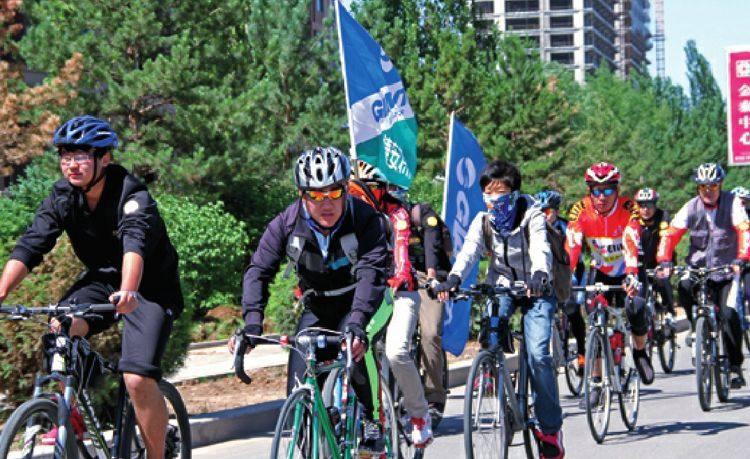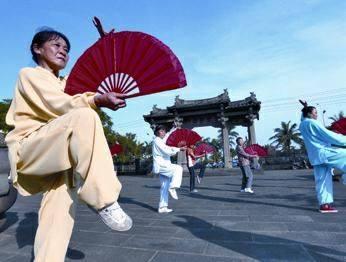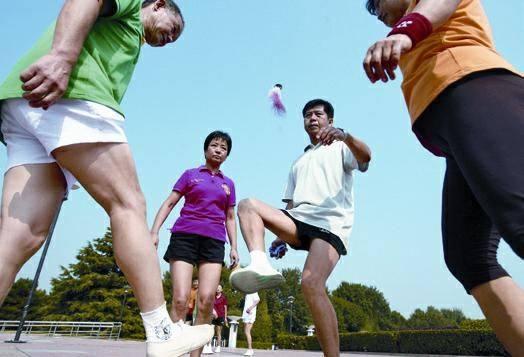CASUAL SPORTS
By Yin Pumin



As Chinese athletes strive for med- als and glory at the London 2012 Olympic Games, their less-gifted countrymen back home are aiming to meet their personal fitness goals by participating in sports.
In June, the first Shanghai Citizens Sports Meeting (CSM), an event intended to help the citys populace get fit, was launched by the Shanghai Municipal Government and will continue until November. The initiative, to be held every four years to correspond with the summer Olympics, will host more than 2,000 games in 50 different sports this year.
It marks the first time a local government has implemented fitness programs in a city-wide sports gala since China unveiled its Outline of Nationwide Physical Fitness Program (NPFP) in 1995 in a bid to promote healthier exercise habits among the people.
“We hope to educate people about the benefits of doing sports; encourage them to join us and gradually make sports a main part of peoples lifestyles through CSM,” said Li Yuyi, Director of the Shanghai Administration of Sports.
“There is no conflict between mass sports and competitive sports. Instead, they are complementary,” Li said. “The outstanding performances of Chinese athletes at the Olympic Games will attract more people, especially children, to fill arenas, and the prospering of mass sports will help enrich the talent reserves of competitive sports.”
The Fourth National Fitness Day fell on August 8 this year. Thousands of people in Beijing marked the day by performing the ninth edition of the countrys broadcast calisthenics. Meanwhile, a basketball tournament for citizens in the capital was launched by the General Administration of Sport (GAS) and Beijing Municipal Government.
Across the country, local governments organized a variety of sporting activities, such as five-on-five football matches, marathons, bicycle races and folk sports events to celebrate the special day.
The First National Fitness Day was held on August 8, 2009, to mark the anniversary of the opening of the 2008 Beijing Olympic Games.
A nationwide campaign
Six decades have passed since the founding of the Peoples Republic in 1949. Within this short time span, China has made great progress in both promoting national fitness and training talented athletes.
China topped the gold medal tally with 51 four years ago at the Beijing Olympic Games, affirming that it has been on the right track to becoming a sports powerhouse.
However, racking up medals is no longer Chinas sole focus, as it moves to promote the health and fitness among the wider population.
“Most importantly, the Beijing Olympic Games have also played a major role in luring more people into the countrys mass sports program,” said Liu Peng, Director of the GAS.
“After the Beijing Olympic Games, more Chinese started to exercise voluntarily as governments and sports authorities paid more attention to mass sports, creating an atmosphere for the progress of sport,” said Sheng Zhiguo, Director of the Mass Sport Department of the GAS.
According to Sheng, a third of the countrys population now participates in sports regularly, up from 28.2 percent three years ago. The overall fitness of Chinese people appears to be improving.
Moreover, more than 1.1 million sports venues have been built around the country, along with more than 250,000 gyms set up in communities, public parks, squares, roadsides and other convenient locations. The number of social sports instructors is approaching 800,000.
This year, the GAS will further earmark 300 million yuan ($47.62 million) from the sale of sports lotteries to build more sports facilities for the general public, according to Liu.
The government has stipulated that 60 percent of the proceeds from the sports lotteries must go to the NPFP.
The lottery, established in 1994, is important for raising funds for sporting and recreation events and for maintaining sports facilities. Thirty percent of the lotterys revenues are used for public projects including sports meetings and mass sports programs, according to the GAS.
With the flourishing of nationwide fitness activities, peoples attitudes have also undergone great changes. In many large and medium-sized cities, spending money in the pursuit of good health has become trendy. Some of the newly emerging sports, including horseracing, yoga, pole dancing, womens boxing, kendo, taekwondo and golf are particularly popular among youth.
The Chinese Government has worked hard to promote the countrys mass sports activities and its peoples fitness.
Aiming to improve the health and physical condition of the general population, the NPFP encouraged everyone to engage in at least one sporting activity every day, learn at least two ways of keeping fit and have a health check every year.
The program ended in 2010, by which time a sports and fitness service system had been set up for the general public. More than 850,000 gymnasiums and stadiums had been built across China, most of which were open to and widely used by the general public.
In order to further improve peoples access to sports facilities, the State Council rolled out the National Fitness Regulations in 2009, aiming to get more of Chinas 1.3 billion people involved in sports.
The regulations emphasized the rights of students to practice sports. It, among other things, has been mandated that schools must ensure one hour each day for students to play sports and set aside at least one “Sports Day” per academic year.
As the previous NPFP expired in 2010, a set of new guidelines for sporting activities known as the National Fitness Program 2011-15 were released in early 2011.
According to the new plan, 32 percent of the population should be getting at least 30 minutes of exercise at least three times a week by 2015. The target is 3.8 percent higher than the number of people who reported exercising in 2007.
In order to provide more opportunities for people to exercise, the number of gymnasiums and stadiums nationwide is set to rise to 1.2 million by 2015.
The government also plans to increase stadium space from todays 1.03 square meters per person to 1.5 square meters in the next five years.“The plan and the goals are based on the current situation and research,” Sheng said.
The targets in the five-year program include a call for 50 percent of cities and counties to set up physical training centers and 50 percent of communities to have convenient and functional sports facilities. The document also urges the promotion of competitive sports, including track and field, swimming, and tennis. In addition, the number of professional physical trainers working in communities should reach 1 million.
In order to ensure the program to be implemented effectively, governments at all levels must include their planned investment in the promotion of fitness programs in their budgets, said Sheng.
“Well conduct a nationwide survey to examine the implementation of the new policy,”Sheng said. “To ensure the accuracy of the result, the Central Government will send out staff to do the survey at the local level, instead of collecting data from local sports bureaus.”
A featured exercise
On August 9, 2010, Beijing restored the long-suspended broadcast calisthenics and encouraged employees of all companies, public institutions and schools to do the exercises during work breaks.
Since then, the local radio station has broadcast the exercise music every day at 10 a.m. and 3 p.m., repeated twice, and lasting about eight minutes. The effort is believed to improve health, especially for those who sit in an office throughout the day.
Surveys have found that the physical condi- tions of many employees are distressing, with a significant number of young people having high blood pressure, heart disease, diabetes and so on. In addition, many office workers suffer from lumbar strain, cervical spondylosis and shortsightedness.
People between the ages of 25 and 65 get the least physical exercise due to the pressures of work upon ones personal lifestyle, according to Jiao Shufang, an expert with Beijing Municipal Center of Disease Control and Prevention.
Broadcast calisthenics refers to a set of simple exercises specially designed for the general public to perform along with recorded commands set to a tempo and broadcast by radio or loudspeaker.
The first edition of broadcast calisthenics was introduced in 1951, when millions of people across the country did exercises to the rhythm of music from China National Radio. Since then, every five to 10 years, the national exercises are switched up according to social development and peoples physical conditions. In 1981, the sixth edition of broadcast calisthenics was launched, the seventh in 1990 and the eighth in 1997.
In an attempt to further improve citizenshealth, China released its ninth edition of broadcast calisthenics on August 8, 2011, to promote national fitness as the past eight programs did.
“The new calisthenics, which took researchers one year to devise and modify, are some of the most economical, practical and scientific ways to exercise the body,” said Feng Jianzhong, Vice Director of the GAS.
Zhang Ping, deputy leader of the group that designed the new regimen, said the calisthenics take about four minutes to complete and will help participants cope with the pressures associated with modern life. They will also help to prevent obesity and high cholesterol, which are becoming common among Chinese students and adults.
Youth concerns
Despite Chinas success at the Beijing Olympic Games and its young peoples rising enthusiasm for sports, a troubling reality cannot be ignored: Chinese people, especially its younger generations, have relatively poor physical fitness compared to that of people in developed countries.
A survey of college students in more than 10 cities earlier this year by the Chinese Health Education Center found that more than 50 percent of respondents do not exercise enough.
Researchers discovered roughly 23 percent were lighter than the ideal weight recommended as healthy by the Ministry of Education and sports administration, while 13 percent were overweight.
A separate study released last year by the Ministry of Education also showed only 21 percent of primary and junior middle schools enforce the minimum exercise time of at least one hour per day. About 56 percent of primary schools and 76 percent of junior middle schools do not arrange enough physical education classes, the report said.
According to the Chinese Association for Student Nutrition and Health Promotion, China had 12 million overweight children in 2011, accounting for about 7 percent of the global total.
In Beijing alone, the number of overweight primary and middle school students hit 20.7 percent in 2011, according to the Beijing Municipal Bureau of Health.
“Its obvious that the physical fitness of students has worsened in recent decades,”said Wang Heping, a teacher at the Beijingbased University of International Business and Economics. “The biggest drops are in endurance and strength, while flexibility is also very bad.”
Yang Yang, the retired speed skater who won Chinas first Winter Olympics gold medal, suggested holding school officials accountable for the amount of exercise children receive at primary and middle school.
To ensure youngsters get at least an hour of sport each day, principals and education departments should be punished if schools do not meet the requirement, she said.

